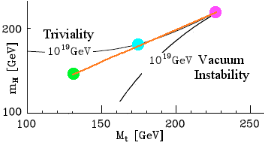Frank Dodd (Tony) Smith, Jr. - March 2013
This paper ( viXra 1207.0028
) is about LHC results announced through
Moriond
2013
( it supercedes my earlier papers ) - FermiLAT Higgs
( it supercedes my earlier papers ) - FermiLAT Higgs
In
the 25/fb of data collected through the run ending with the long
shutdown at the end of 2012,
the LHC has observed a 126 GeV (about 133 proton masses) state of the Standard Model Higgs boson.
In my E8 Physics model the Higgs/Tquark system has 3 mass states
with the low-mass Higgs state calculated in my E8 Physics model to be
126.257 GeV.
the LHC has observed a 126 GeV (about 133 proton masses) state of the Standard Model Higgs boson.
In my E8 Physics model the Higgs/Tquark system has 3 mass states
The 3-state Higgs-Tquark system also
has, near the Higgs Vacuum
Expectation Value around 250 GeV,
as well as a mid-mass state around 200 GeV at which the system renormalization path enters conventional 4-dim Physical Spacetime, departing from the Triviality boundary at which an (4+4)-dim Klauza-Klein spacetime is manifested.
Here are some details about the LHC observation at 126 GeV and related results shown at Moriond 2013:
The digamma histogram for ATLAS
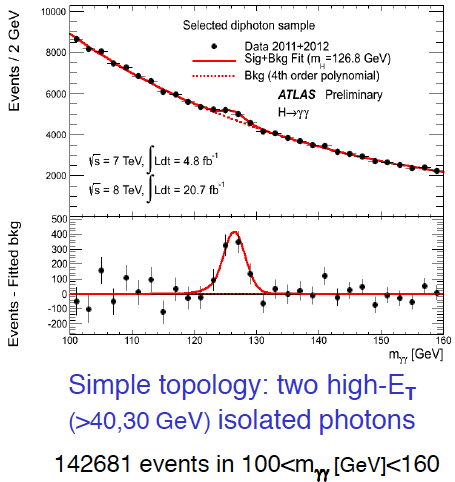
clearly shows only one peak below 160 GeV and it is around 126 GeV.
CMS shows the cross sections for Higgs at 125.8 GeV
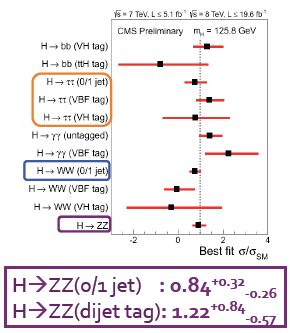
to be substantially consistent with the
Standard Model for the WW and ZZ channels,
a bit low for tau-tau and bb channels (but that is likely due to very low statistics there),
and a bit high for the digamma channel (but that may be due to phenomena related
to the Higgs as a Tquark condensate).
a bit low for tau-tau and bb channels (but that is likely due to very low statistics there),
and a bit high for the digamma channel (but that may be due to phenomena related
to the Higgs as a Tquark condensate).
A CMS histogram (some colors added by me) for the Golden Channel Higgs to ZZ to 4l shows the peak around 126 GeV (green dots - lowHiggs mass state. The CMS histogram also indicates other excesses
around 200 GeV (cyan dots - midHiggs mass state)
and around 250 GeV (magenta dots - highHiggs mass state).
An image of one of the events is shown below the histogram.
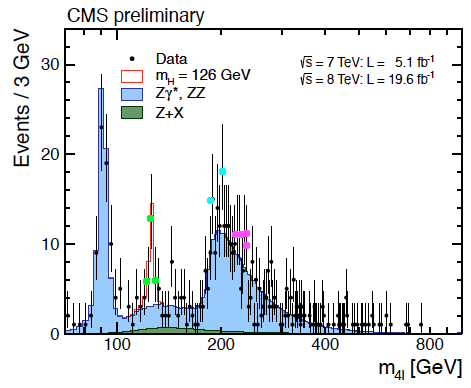
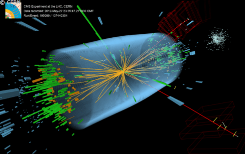
An ATLAS ZZ to 4l histogram (some colors added by me) show the peak around 126 GeV (green dots - lowHiggs mass state. The ATLAS histogram also indicates other excesses around 200 GeV (cyan dots - midHiggs mass state)
and around 250 GeV (magenta dots - highHiggs mass state) . An image of one of the events is shown below the histogram.
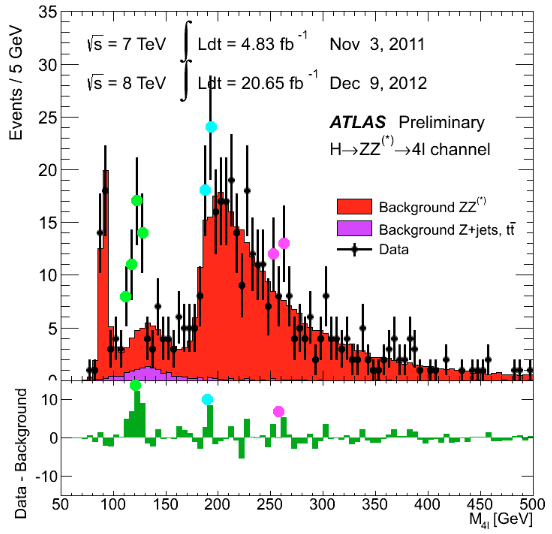

CMS showed a Brazil Band Plot for the High Mass Higgs to ZZ to 4l/2l2tau channel
where the top red line represents the expected cross section of a single Standard Model Higgs
and the lower red line represents about 20% of the expected Higgs SM cross section.

The green dot peak is at the 126 GeV
Low Mass Higgs state with expected Standard Model cross section.
The cyan dot peak is around the 200 GeV Mid Mass Higgs state expected to have about 25% of the SM cross section.
The magenta dot peak is around the 250 (+/- 20 or so) GeV High Mass Higgs state expected to have about 25% of the SM cross section.
The (?) peak is around 320 GeV where I would not expect a Higgs Mass state
and I note that in fact it seems to have gone away in the full ATLAS ZZ to 4l histogram shown above
because between 300 and 350 GeV the two sort-of-high excess bins are adjacent to deficient bins.
The cyan dot peak is around the 200 GeV Mid Mass Higgs state expected to have about 25% of the SM cross section.
The magenta dot peak is around the 250 (+/- 20 or so) GeV High Mass Higgs state expected to have about 25% of the SM cross section.
The (?) peak is around 320 GeV where I would not expect a Higgs Mass state
and I note that in fact it seems to have gone away in the full ATLAS ZZ to 4l histogram shown above
because between 300 and 350 GeV the two sort-of-high excess bins are adjacent to deficient bins.
It will probably be no earlier than 2016 (after the long shutdown) that the LHC will produce substantially more data than the 25/fb available at Moriond 2013 and therefore no earlier than 2016 for the green and yellow Brazil Bands to be pushed down (throughout the 170 GeV to 500 GeV region) below 10 per cent (the 10^(-1) line) of the SM cross section
as is needed to show whether or not the cyan dot , magenta dot, and/or (?) peaks are real or statistical fluctuations.
My guess (based on E8 Physics) is that the cyan dot and magenta dot peaks will prove to be real
and that the (?) peak will go away as a statistical fluctuation,
but
whatever the result,
it is now clear that Nature likes the
plain vanilla Standard Model
(with or maybe without a couple of Little Brother Higgs states, where Little refers to cross section),
so: (with or maybe without a couple of Little Brother Higgs states, where Little refers to cross section),
With
the Standard Model firmly confirmed, what should physicists do in
the future ?
Here are 4 things to think about:
1 - Since the Higgs came from Solid State Physics ideas of people like Anderson,
look closely at Solid State Nanostructures
( such as Nickel/Palladium that seems to be useful in Cold Fusion - vixra 1209.0007 )
to see whether they can show new ways
to visualize the workings of High-Energy Physics of the Standard Model plus Gravity.
2 - If conventional 1-1 fermion-boson SuperSymmetry is not Nature's Way,
can we get the nice cancellations from a more Subtle SuperSymmetry ?
For that, my model uses a Triality-related symmetry between fermions and gauge bosons
based on its 8-dim Kaluza-Klein structure.
3 - What about Dark Matter and Dark Energy?
My model uses the Spin(2,4) = SU(2,2) Conformal Group of Irving Ezra Segal to account for both,
but it is experimental observation that counts.
An experimental approach of Paul A. Warburton at University College London
uses terahertz frequency Josephson Junctions - vixra 1209.0109 -
Warburton said (IEEE Applied Superconductivity Conference, Chicago 2008):
"... We have fabricated intrinsic Josephson junction arrays ... and discuss ...
the application of intrinsic junctions as THz sources and qubits ...".
See also arXiv 1206.0516 by Xiao Hu, Shi-Zeng Lin, and Feng Liu entitled
"Optimal Condition for Strong Terahertz Radiation from Intrinsic Josephson Junctions"
and arXiv 0911.5371 by Xiao Hu andShi-Zeng Lin entitled
"Phase dynamics of inductively coupled intrinsic Josephson junctions
and terahertz electromagnetic radiation"
4 - What about the High Energy Massless Realm well above Electroweak Symmetry Breaking:
What happens to Kobayashi-Maskawa mixing in a Realm with no mass ?
How do you tell a muon from an electron if they are both massless ?
To find out, build a Muon Collider. In hep-ex00050008 Bruce King has a chart
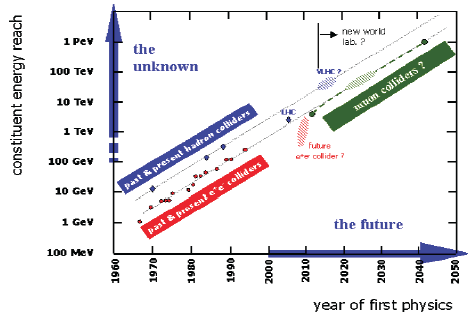
and he gives a cost estimate of about $12 billion for a 1000 TeV ( 1 PeV ) Linear Muon Collider
with tunnel length about 1000 km. Marc Sher has noted that by now (late 2012 / early 2013) the cost
estimate of $12 billion should be doubled or more.
My view is that even a cost of $100 billion is comparable
to the cost of the USA Navy construction program for 10 Gerald R. Ford - class aircraft carriers by 2040
and
is substantially less than the amount of money being printed up by USA Treasury/Fed Quantitative Easing
which has since 2008 been giving Trillions of USA dollars to USA Big Banks every year.
Unlike Quantitative Easing giving money to Big Banks who keep it to themselves and their close friends
construction of Big Physics Machines could be effective in creating jobs,
encouraging people to understand Nature through Science,
and
being an example of peaceful cooperative development
as opposed to destructive military/economic competition.
